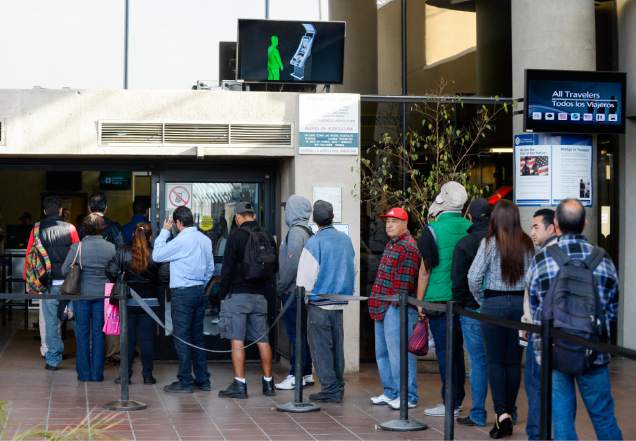For the first time, the identities of foreigners leaving the United States through a land border are being checked with high-tech biometric equipment capable of reading faces and irises.
U.S. Customs and Border Protection has started screening pedestrians crossing into Mexico at Otay Mesa in a field test aimed a determining how the readers works in a land setting. The new procedures are part of a move by the U.S. Department of Homeland Security aimed at gaining greater information about who leaves the United States.
The test, which is scheduled to conclude on April 29, is part of an effort that uses biometrics to crack down on identity theft as well as to keep track foreigners who remain in the United States with expired visas. For the next few weeks, all pedestrians leaving San Diego through Otay Mesa will be subject to screening, but only foreigners will have their identities documented through iris and facial recognition technology. The testing is taking place Monday through Friday, from 7 a.m. to 10 p.m.

Pedestrians crossing from Mexico into the United States at the Otay Mesa Port of Entry wait (Photo: sltrib.com)
“We want to know when a person comes into the country, and we want to know when they leave,” said Charmaine Rodriguez, assistant port director at Otay Mesa.
Biometrics measure a person’s unique physical characteristics, through methods that include the reading of fingerprints, irises and facial structure. CBP has been verifying travelers’ identities through fingerprints since 2004.
On Thursday morning, a trickle of crossers walked into Mexico, being directed to different biometric readers set up beneath a large white canopy. Some pushed bicycles, others carried groceries or pulled luggage.
“It’s not a bother,” said Jesús Martínez Sánchez, 57, a Tijuana furniture store employee who was returning to Mexico after doing some paperwork for his son-in-law in San Diego. “It would be a bother if there were a lot of people.”
The testing responds to a longstanding demand by Congress that DHS track foreigners who remain in the country after their visas expire. A 2006 study by the Pew Hispanic Center estimated that visa overstays made up as much as half of the country’s undocumented population.
Though legislation imposing penalties on those who overstay their visas dates back to 1996, “this really came to light after the 9/11 attacks, when it was difficult to determine with a degree of certainty if individuals had left the country,” Rodriguez said.
Except for sporadic checks for guns, bulk cash and stolen vehicles by U.S. authorities, those crossing into Mexico by land rarely submit to U.S. inspections. Until now, there has been little scrutiny of pedestrians leaving the country through Otay Mesa either by U.S. or Mexican authorities.
The new southbound inspections at Otay Mesa began last week, and represent the second phase of a test that was launched in December. The first phase has involved using readers to capture biometric information of non-U.S. citizens entering the United States on foot through the Otay Mesa Port of Entry, creating a database for the test.
The southbound inspections, the first of their kind at a U.S. land border crossing, separate crossers into U.S. citizens and non-U.S. citizens.
U.S. citizens with passport cards or other radio-frequency identification documents (RFID) that can be read by machines are being asked to swipe their cards before crossing, registering their departure. Those with passport books are directed to kiosks that read the information.
The biometric testing applies to most non-U.S. citizens between the ages of 14 and 79. Those with RFID documents are being directed to either of two lanes. One lane tests “on the move” technology, and crossers are instructed to continue walking, but look into a camera as they pass through. Crossers sent to the other lane, called “pause and look” are told to stop for about five seconds while a camera captures an image. Those foreigners without RFID documents are sent to the kiosks.
The testing will help CBP decide what tracking methods can be most successful at land borders.
“It’s a much different environment than an airport or cruise ship terminal,” Rodriguez said. “We’re dealing with different types of lighting, with people who are wearing hats, sunglasses…. The fact that they need to continue to move forward as they’re looking at the camera is difficult sometimes in this environment, as they’re struggling with luggage or minding their children.”
According to CBP, 9,000 pedestrians a day cross into the United States through the Otay Mesa Port of Entry, while about 6,000 leave the country. “The majority of the technology is meant to be minimally intrusive on the traveler,” Rodriguez said. The test data is being kept in a local database and not being shared with other law enforcement agencies, she said.
Anyone found to have overstayed their U.S. visa will be processed “on a case-by-case basis.” Inspectors “would use our normal processing for a person who has overstayed their visa. It might be a simple annotation versus a more formalized process,” Rodriguez said.
Source: http://www.govtech.com/


